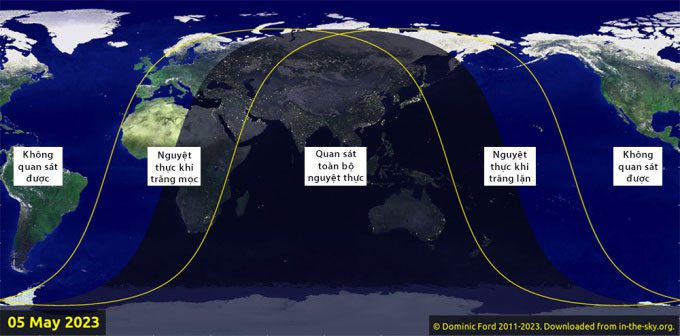The Moon will enter the outer shadow of the Earth on May 5, creating a penumbral lunar eclipse, which will make the Moon appear dimmer but not completely disappear.

A map showing the areas where the penumbral lunar eclipse on May 5 can be observed. (Photo: Dominic Ford/In-The-Sky.org).
The penumbral lunar eclipse will begin at 10:15 PM on May 5 (Hanoi time) and can be observed from anywhere the Moon is above the horizon, including Antarctica, Asia, Russia, Oceania, and East and Central Africa. The event will peak at 12:24 AM on May 6 and end at 2:32 AM the same day, when the Moon exits the Earth’s shadow.
Like all types of lunar eclipses, a penumbral lunar eclipse occurs when the Earth passes between the Moon and the Sun. This causes the Earth to block sunlight and cast a shadow on the Moon.
A penumbral eclipse occurs when the Moon enters the lighter outer part of the Earth’s shadow, known as the penumbra. This is the area where the Earth appears to partially obscure the solar disk, rather than blocking it entirely. While in the penumbra, the Moon receives less sunlight. For observers on Earth, the Moon appears darker but does not completely vanish.
This effect can be subtle and is sometimes only noticeable in detailed photographs or by those with exceptionally keen eyesight. However, there are occasions when the entire Moon moves into the penumbra. These rare lunar eclipses create a more pronounced dimming effect and can be more easily seen with the naked eye. Such events are known as total penumbral eclipses and are quite rare, as once the Moon fully enters the penumbra, it is likely that at least part of the Moon will touch the umbra – the darker inner part of the Earth’s shadow. This results in a partial eclipse instead of a penumbral one.




















































